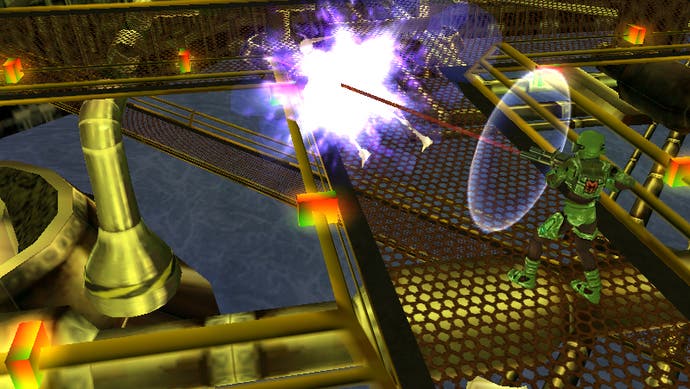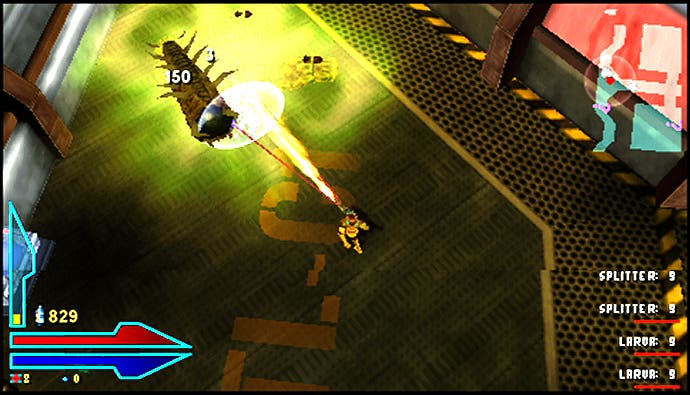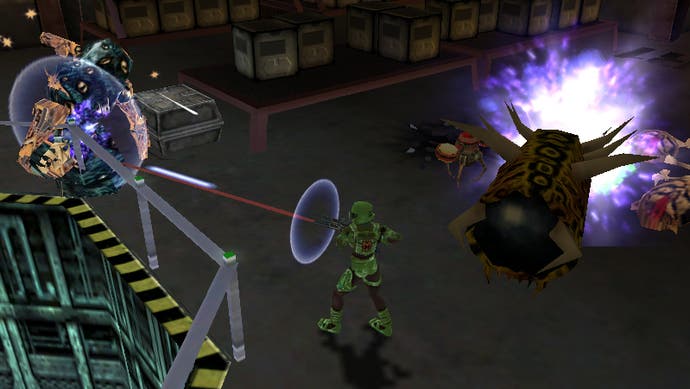Alien Syndrome
Bad remake syndrome strikes again.
Waiting 15 or 20 years to release a sequel is perhaps not the most astute way to build a brand, but this is becoming a bit of a bad habit for SEGA. Remember the appalling remake of Altered Beast? Or worse, Shinobi? This week, it's Alien Syndrome's turn - a brand that's been left to gather dust since it debuted in arcades back in 1987. And guess what? It's not very good either. Sigh. Why do you do this to us, SEGA? If you can't transform these old relics into amazing games, just leave them be.
The concept is superficially similar to the charming old arcade game of the same name - you're sent out to investigate a space station after communications are lost and find it over-run by aliens. Trooper Aileen Harding takes it upon herself to send thousands of them to their squishy doom one-by-one, while her commander barks orders impatiently in her ear. Somewhere along the line there's a thin sub-plot that you're trying to determine whether there are any survivors, but in basic terms this quickly turns into one of the most relentlessly repetitive action RPGs you've ever played. Totally Games: what happened? You used to make exceptional products. Alien Syndrome feels lazy, uninspired and just plain boring - yet somehow mindlessly addictive for reasons I'll have to check with my shrink about.
The 'hook' of the game, if there is one, is the RPG-level of customisation and variation in how you tackle the combat and upgrades. At the start you can select from a Demolitions Expert, Firebug (i.e. Flamethrower skills), a Seal (survival expert), a Tank (melee specialist), and a Sharpshooter, which certainly gives the impression that there's a fair degree of freedom to play it in a way that suits your own preferences and whims. Such an approach also encourages you to take advantage of the four-player co-op mode, so that, perhaps, you can form a team which covers off all bases, Gauntlet-style. That said, the chances of getting four people together to play this are extremely slim, so it's perhaps wise not to dwell on this promising feature too much.

Set across 15 levels, the general gist is simply to blast everything you see, vacuum up the collectables (such as new weapons, ammo, medikits, armour and the like) and move on through the level until you reach some sort of exit. Sometimes you might be asked to flick a switch or two somewhere, or take down a boss in order to get the key that you require, but in a general sense that's all you do. You run from point from A to B. You shoot (a lot), you kill hundreds of slimy critters per level, you periodically upgrade your character with new weapons and armour, and then spend the skill points you've earned however you see fit. And then you keep on doing that until your eyes fall out, your tolerance for repetition expires, your friend's tolerance for watching you do the same things over and over expires, or your battery expires. Whichever comes first.
At first, the game seems quite promising in an action RPG-flavoured Alien Breed kind of way. The game engine's attractive enough on the confines of the PSP's fantastic screen, and the controls aren't too shabby either. Viewed from a scalable isometric viewpoint, the game more than makes up for the lack of a second stick by automatically rotating the viewpoint as required, and keeps the camera zoomed out in a sensible way to keep just the right amount of the game in view, while also being close enough to make the most of the nicely detailed environments and well-animated character models. The controls are simple and intuitive, with an initially fiddly aiming system which soon becomes second nature. At first, it feels wrong to not be able to change the direction of your fire once you've hit the fire button, but once you adapt to being able to strafe left and right, you begin to make the most of being able to dodge enemy fire, and/or back-off when you need to. It's perhaps not ideal, but it works well, and that's the main thing.

To begin with, you'll get used to running down narrow corridors and exploring the ship's innards, facing wriggling, giant slug-like creatures which subdivide but pose little immediate threat so long as you get a bead on them and strafe left and right. Then the game starts spawning aliens that spit projectiles at you, or sharp, spinning, blade-like foes, or ones who gang up and electrocute you. The game boasts over 80 enemies in total, and part of the fun is seeing what the game can throw at you next, be they foes which spawn others that hunt you down, or ones which knock you completely off-balance and leave you defenceless for a moment. Occasionally the game will up the ante even further and throw a giant boss at you, but it's all in-keeping with the well-worn traditions of the typical action RPG: a lot of enemies, and a whole lot of killing.
But while it shares a few common concepts with the 1987 original, it's about a million times easier to play. In fact, the thing we found absolutely incredible relatively early on was just how easy the game makes things for you. Once you throw on some armour (available all over the place), find better versions of your chosen weapon and pick up a few items which help regenerate your health and ammo, it's practically impossible to die. If you choose to play as the Seal, for example, and keep upgrading your (already very high) Endurance levels, and spend points on upgrading the Recharge and Bio Regen proficiencies, then you'll get to a stage when you'll almost never have to worry about picking up health packs or recharging your weapon energy. The reason for this is that both will eventually regenerate at a rate roughly equal to the amount being consumed. By about the fourth or fifth level of the game, you'll begin to feel like you're playing on God Mode, just wading right up to enemies with your finger held down on the fire button until they all eventually sod off. It all feels a bit broken, to be honest. Someone clearly didn't think the tech tree through.

Of course, killing hundreds of enemies earns you a ton of experience, and as you level up you feel compelled to see what upgrades you can get, and what new weapons abilities become available. So you keep playing to see if maybe the game gets better a little further down the line. But it stays roughly the same, with your brain parked firmly in neutral just blasting mindlessly away in the hope of a flicker of entertainment. But it doesn't come. Alien Syndrome is pretty inoffensive, quite easy on the eye, and technically sound, but is about as uninspired an action RPG experience as you could imagine. It's just grind, grind, grind, and making yourself super-powerful in the process. Sure, new enemies arrive from time to time that make things slightly more interesting, but the general vibe is of a game that was churned out with precious little imagination. The fact that you could possibly use melee combat or explosives instead of laser fire is really not very exciting - the net result is precisely the same.
Alien Syndrome had the potential to be a decent by-the-numbers action RPG, but it struggles to even reach those heights with insipid repetition and a total lack of challenge crippling your incentive to see it beyond the first few hours. One to file under SEGA's mistakes, then.

